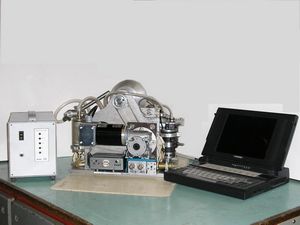Main Sector of relevance\IRC classification 8. Industrial Manufacturing, Material and Transport Technologies
8.20 Finishing technology for optical and semiconductor parts with the use of magnetorheological fluids
Developers’ contact information
State Scientific Institution “The A.V.Lykov Institute of Heat and Mass Transfer of National Academy of Sciences of Belarus”
15 P.Brovka Street, Minsk BY-220072
Tel.: +375 (17) 284-21-38, fax: +375 (17) 292-25-13
Summary
The magnetorheological finishing technology (MRFT) is a computer-monitored final polishing process for optical and semiconductor parts ensuring both high geometric precision and high quality grade of their surface. The magnetorheological finishing method is based on regulating magnetorheological fluid (MRF) properties by means of magnetic field variation. Magnetic field converts thin-consistency MRF into a viscoplastic medium suitable for finishing of various materials.
Description
The MRFT is realized through different magnetorheological
finishing module (MRFM) constructions (one of them is shown on Figure 1) and
various MR compounds. The MRFM is mounted on a base machine, its kinematical
scheme and construction chosen according to the type and identification data on
optical and semiconductor parts under treatment. The MRFT is a fully automatic
computer-monitored treatment process which, unlike other common finishing
technologies, requires no time-consuming tool preparation and part-specific
size adjustment.

Fig. 1 – Magnetorheological finishing module
Various MRFM constructions and base machine configurations allow final
polishing of parts of all geometrical forms: spherical, aspherical, bowed and
dished, flat. The size range is from 5 mm to 2m and more. Magnetorheological
finishing is suitable for such materials as noted below:
Technology type
Technical advantages and economic benefits
The MRFT ensures high-quality and high-precision part surfaces, which remains an impossible task for standard finishing technologies. Surface roughness mean root square value, Rq, can amount to 3 ÷ 10 Angstrom units while form defect mean root square value σ rms, is ± λ/60÷λ/100 (λ=0,6328 μm).
Technology differentiation and uniqueness
Cooperation with optical and electronic production enterprises for the purpose of constructing magnetorheological finishing packages and machines to process all kinds of high-precision optical parts, astronomical optics as well as semiconductor plates.
Context in which technology was identified
At the Federal State Unitary Enterprise “Scientific Production Association “Optika””, RF, Moscow (FSUE “SPA “Optika””).
Technological keywords
Magnetorheological finishing technology, magnetorheological fluid, magnetorheological finishing module, optical and semiconductor parts.
Development Stage
Intellectual property rights
Range of applications
Magnetorheological finishing technology as well as the developed
equipment can be used in production:
Classifier Used at the EU Innovation Relay Centres
Preferable Regions
Practical experience
State scientific institution “Heat and Mass Exchange Institute
of the National Academy of Sciences of Belarus” have been carrying out
researches on magnetorheological finishing since 1990. Together with Optical
Production Center of the University of Rochester, USA, it also held some
cooperative research activities concerned with studying fundamental basis for
magnetorheological fluid production intended for optical parts polishing. Their
joint activities resulted in a revolutionary and world-renowned technology
named magnetorheological finishing (MRF) (as per international
nomenclature).
In 2006÷2008 State scientific institution “Heat and Mass Exchange Institute
of the National Academy of Sciences of Belarus” cooperated with FSUE “SPA
“Optika”” to develop a test model of an optical part finishing module
based on use of magnetorheological fluids.
In 2008 they conducted studies in accordance with an agreement on constructive
cooperation concluded between SSI “Heat and Mass Exchange Institute of the
National Academy of Sciences of Belarus” and the Institution of the RF
Academy of Science “Institute of High-purity Substances Chemistry” (IRFAS
IHPSC).
“Application of magnetorheological finishing technology to process zinc
chalcogenide optical semiconductor products”. The results of the experiments
testify to a possible high-quality finishing for polycrystalline zinc sulphide
with the use of magnetorheological finishing technology.
Environmental impact
When applying the magnetorheological finishing technology it is essential to follow all the norms and regulations specified for certain material finishing operations in optical and electronic industries. Magnetorheological fluids used for MRF are not toxic and they have no environmental impact.
Type of collaboration sought
Terms and restrictions
—
Available technical assistance